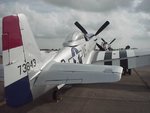MikeGazdik
Senior Airman
Have always been curious, and since right now I have been on a Corsair kick, I know I'm on the perfect forum to ask.
When looking at the tail / fuselage design of the Corsair, it is much different than most of the contemporary fighters. The rear fuselage keeps its form shape from the cockpit all that way to the end of the tail cone. It doesn't blend into the vertical tail. The vertical tail appears to be "set" onto the structure.
Whereas if you look at the P-51, the fuselage blends into the shape of the vertical tail. And most every other fighter I can think of right now.
Which of these two designs is cleaner and what are any advantages or negatives of either design?
When looking at the tail / fuselage design of the Corsair, it is much different than most of the contemporary fighters. The rear fuselage keeps its form shape from the cockpit all that way to the end of the tail cone. It doesn't blend into the vertical tail. The vertical tail appears to be "set" onto the structure.
Whereas if you look at the P-51, the fuselage blends into the shape of the vertical tail. And most every other fighter I can think of right now.
Which of these two designs is cleaner and what are any advantages or negatives of either design?

